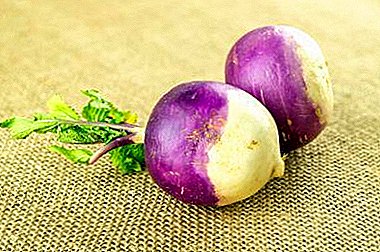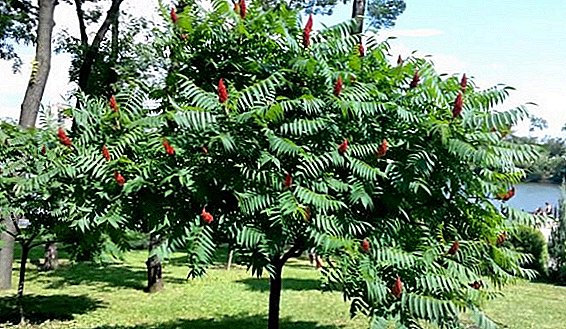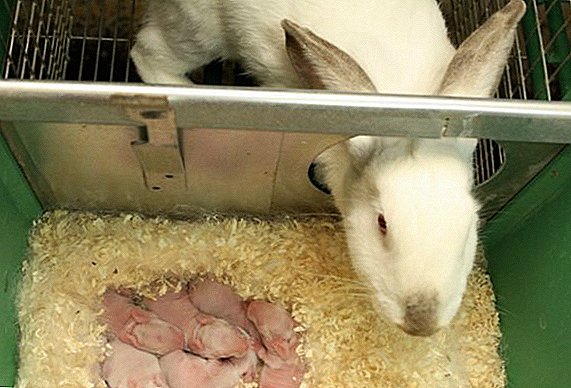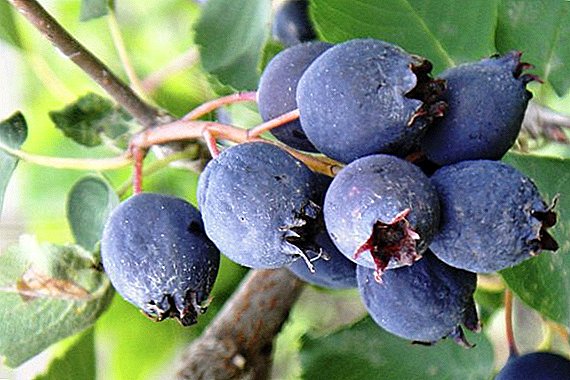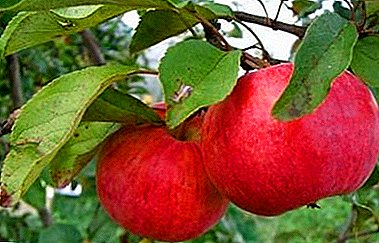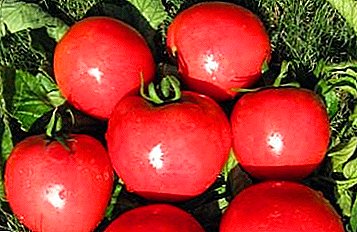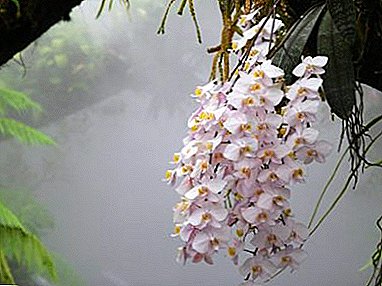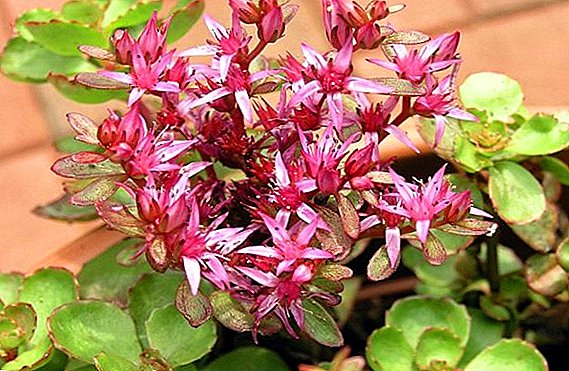 If your attention was attracted by a picturesque floral carpet, which seems to be spreading like a bright spot on a flower bed, a hill or a selected area, most likely you will see an overgrown stonecrop false. Unpretentious, shade-loving, undemanding, frost-resistant succulent decorative perennial.
If your attention was attracted by a picturesque floral carpet, which seems to be spreading like a bright spot on a flower bed, a hill or a selected area, most likely you will see an overgrown stonecrop false. Unpretentious, shade-loving, undemanding, frost-resistant succulent decorative perennial.
Botanical description
Herb plant keeps on creeping rhizome. In height usually does not exceed 25 cm.
From the root a creeping stalk branches, it can be of two types:
- vegetative (barren) - height from 3 to 6 cm, on which a handful of green leaves;
- fertile (fertile) - at its height from 6 to 22 cm, the leaves are usually few in number and fall off most quickly.
Find out what stonecrop are.

Flowers can be collected in inflorescences, depending on the variety:
- umbrella-shaped in the form of a shield;
- playohazyalnye.
The flower calyx consists of 5 divided fleshy sepals, shaped like a narrow green or reddish-green color lancet, which are later preserved around the fruit.
Petals of pleasant pink and purple hues, in the amount of 5 pieces, exceed sepals by a length of 2-2.5 times and form a rim. They retain the lanceolate form, thin, pointed upward, stretch to the top, as if assembled in a cap.
Find out what a remarkable purple, large, prominent stonecrop.
On the red or pink color of the 10 staminate filaments, which are inferior in length to the petals, there are orange-red anthers in the shape of an ellipse. Stamens grow by 30% of their length. Gynetsa is represented by 5 sessile pink carpets accreted at the base. They make such short columns crowned with apical stigmas. Ovary during fruiting retains a direct form, does not diverge.

The fruits have a complex form of a multi-seeded leaflet. Form - straight oblong ovoid, combined in 5 pieces, 1 mm X 0.5 mm, reddish in size. Very small seeds, up to 1 mm in size, in large quantities. In shape oblong with blunt tips. The seeds are arranged without a thickening on the inside and do not bristle like an irregular asterisk - this is another visual difference between the sedum and the variety of plant varieties.
Spread
In general, the plant is cultivated for decorative purposes. But this process has a downside - Sedum spurium runs wild. Although in this form it can be found everywhere:
- Eastern Europe;
- Caucasus (Azerbaijan, Armenia, Georgia, Russian regions of the Caucasus);
- northwest Iran;
- Turkey;
- Western Armenia;
- Ciscaucasia;
- western part of Transcaucasia;
- partly in Dagestan;
- and eastern Transcaucasia.
Did you know? Scientific name of the plant in - "sedum" derived from the Latin verb sedare and translated as "pacify". The fact is that extracts of many stonecrops have a sedative effect, and in traditional medicine they are used as an anesthetic and sedative.

Growing at home
Quite a bit of zeal, and the succulent decorates the interior of your garden, the roof of buildings or flower beds. In the previously prepared soil or in a shallow, but wide flowerpot, we make a recess and plant a cutting or part of an adult plant with a root.
Conditions of detention
Of course, the best period is spring, but in general the plant takes root well at any time.
What Sedum can be capricious about is the matter of lighting. He likes light very much, it is better to place the flowerpots on the windows that face the south side, but as an option - the east or west side. With a lack of light, the plant changes in such a way that it is difficult to even identify it.
Important! If the stalks of the bush are thin and stretch upwards - review the placement of the stonecrop or organize additional sources of light.

In the natural environment, the succulent is used to changing seasons, so if you grow it on a window sill, in winter it is better to move the pot to a cooler place, with an average temperature of up to 14 ° C.
Find out what conditions are preferred by Cranberry Morgan and Coneless Stonecrop.
Soil and fertilizer
As any plant, stonecrop prefers fertile garden soil. Or enriched with a normal amount of humus or compost. Oversupply can trigger the most unexpected visual changes. And if the way they grow up can suit you, then the loss of frost resistance and the chance not to survive the wintering can disrupt your plans.
Sedum is not friendly with nitrogen fertilizers. The best option is a weak concentration of potassium phosphate fertilizers.
Watering and moisture
For succulent soil moisture is very important, the excess should be initially removed by means of drainage. It is important. For example, cultivated varieties easily tolerate dry periods, but false stonecrop, if you dry the soil, may even die, and will have to rejuvenate your green oasis on the windowsill. 
Breeding
The easiest way to transplant sedum is to pull out several young plants with roots from the moistened soil and transplant them to a new place. But in principle, Sedum can be propagated with the help of seeds or vegetatively.
Seeds
As we already know, spring is the best time for a transplant. If in March they are planted in boxes, then in April it will be possible to transfer them to open ground or new flowerpots.
To do this, in a box they are sown on the surface of the soil. It is necessary to water from the spray. Then close with glass or a piece of plastic and place either in a room with a temperature of + 5 ° C ... + 7 ° C, or in an apartment setting on the bottom shelf of the refrigerator (where vegetables are stored). If neither the first nor the second option is available, put the seedling container / drawer in a plastic plastic bag and tie it up.
The term of stratification is two weeks. All this time crops need to be moistened and aired. After 2 weeks in a low temperature regime, we transfer it to a warm room and wait another 2-4 weeks before the appearance of the first seedlings. The first 2 leaves will need to dive. 
Learn how to grow agave, adenium, aihrizone, aloe, zamiokulkas, kalanchoe, lithops, euphorbia, yucca, echeveria, fatty meat, hatiora, havortiya, mammilaria, stapelia, pachipodium, ripsalis.
Vegetative
Vegetative ways easier. Dividing bush with the preservation of part of the rhizome can be carried out at any convenient time (and before and after flowering). The source bush is 4-5 years old.
Another option is grafting. Here it is important that the soil is loose and when cutting from the parent plant it is desirable to preserve at least a few buds, one of which should be rooted to the ground. Feeding is not required.
Or leaves. Torn off or cut off leaves are shallowly placed in the ground, wetting the soil. After 3-5 weeks they will take root. Blossom approximately on the 2nd or 3rd year of life.

Pruning
Pruning is carried out for two purposes:
- free from dry or weak leaves and stems, before and after the season;
- the second option is to prevent the succulent from blooming. There are varieties in which the leaves and stems are much more decorative and exotic, and do not even allow them to bloom.
Wintering
Most of the plants growing in the open field do not require special preparation for winter. But it is important when you clean and refresh the bed in the spring, - save the overwintered leaves as much as possible, they will be very necessary for the plant.
Before wintering the plant stop watering. We carry out pruning, leaving stems 3-5 cm tall. You can just sprinkle them with earth or cut shoots.
Some varieties of Sedum should be insulated for the winter, and in the spring to remove the layer of debris and provide access to fresh air and light.
Did you know? Many varieties of blipers are not just hardy and cold-resistant, but their leaves remain evergreen. They even retain their beautiful shape and color under the snow. The basis of this miracle is the ability of a plant to produce in a cold time a certain substance, a peculiar "antifreeze". It allows the cell sap to not freeze and not to break down the cells.

Possible difficulties in growing
Difficulties in care often arise with breeding varieties. They are expressed in the fact that with a lack of attention, the plant seems to degenerate; it gradually returns to the original classical form and variety throughout the bush.
And the more exotic the shape and color of the leaves, the color of the flowers you grow, the more capricious it is. Perhaps you should focus on the fact that you should regularly pick off the shoots of the usual green color, and then you will keep the uniqueness and exclusivity of the variety of your sedum.
Find out which succulents prefer to grow as indoor plants.
Due to its nature, stonecrop is not a team player enough, it smoothly clogs all the neighbors in the garden. Therefore, it is best to allocate an individual territory for it, taking into account the fact that it is still spreading out in a season.
It is better to land in a group, it is cozy on a stone slide or in a part of the garden where there are stone fences. Sloped areas, such as roofs, snags or ceramic / stone decorations.

Pests, diseases and prevention
In principle, the plant is very resistant to all sorts of diseases and pests. But there are several "diagnoses" that can affect shrubs, but this is most likely an exception to the rule:
- downy mildew - white powdery plaque, fungal nature, causing drying of the leaves;
- powdery mildew - a fungus that infects different parts of a plant;
- stains on the sheet plates - also a fungal disease, the affected leaves need not just to be removed, but to burn.
As for pests, the plants in the room, of course, are less often affected, but if you see caterpillars, bugs and some of the flying creatures of God in the flowerbed, spray insects into the plant as part of prevention.
Learn how to deal with ants, slugs, bears, moles, mole rats, shrews on the site.
Soil moisture is a matter of principle, with all its stability the plant can be affected by the rot of the root system, if there is an excess of moisture. Therefore, drainage can also be attributed to an important part of disease prevention. 
Important! Perhaps you will encounter the fact that it is difficult to find drugs specifically for sedum - use products for black currant bushes, they will not harm stonecrop.Sill false - simple to care, unpretentious and very pretty flowering plant. Tireless folk medicine claims that its juice can even be used for ulcers, burns, and mixed sedum juice with beer is a cure for gout, warts and corns. And warns that by itself, the juice is quite aggressive, it can cause itching and burning. But we perceive it more visually, as an element of garden decor. Moreover, the process of growing and care can involve even children. By doing so, he gains even more sympathy as one of the best elements for green design.
Video: how to multiply and grow stonecrop


